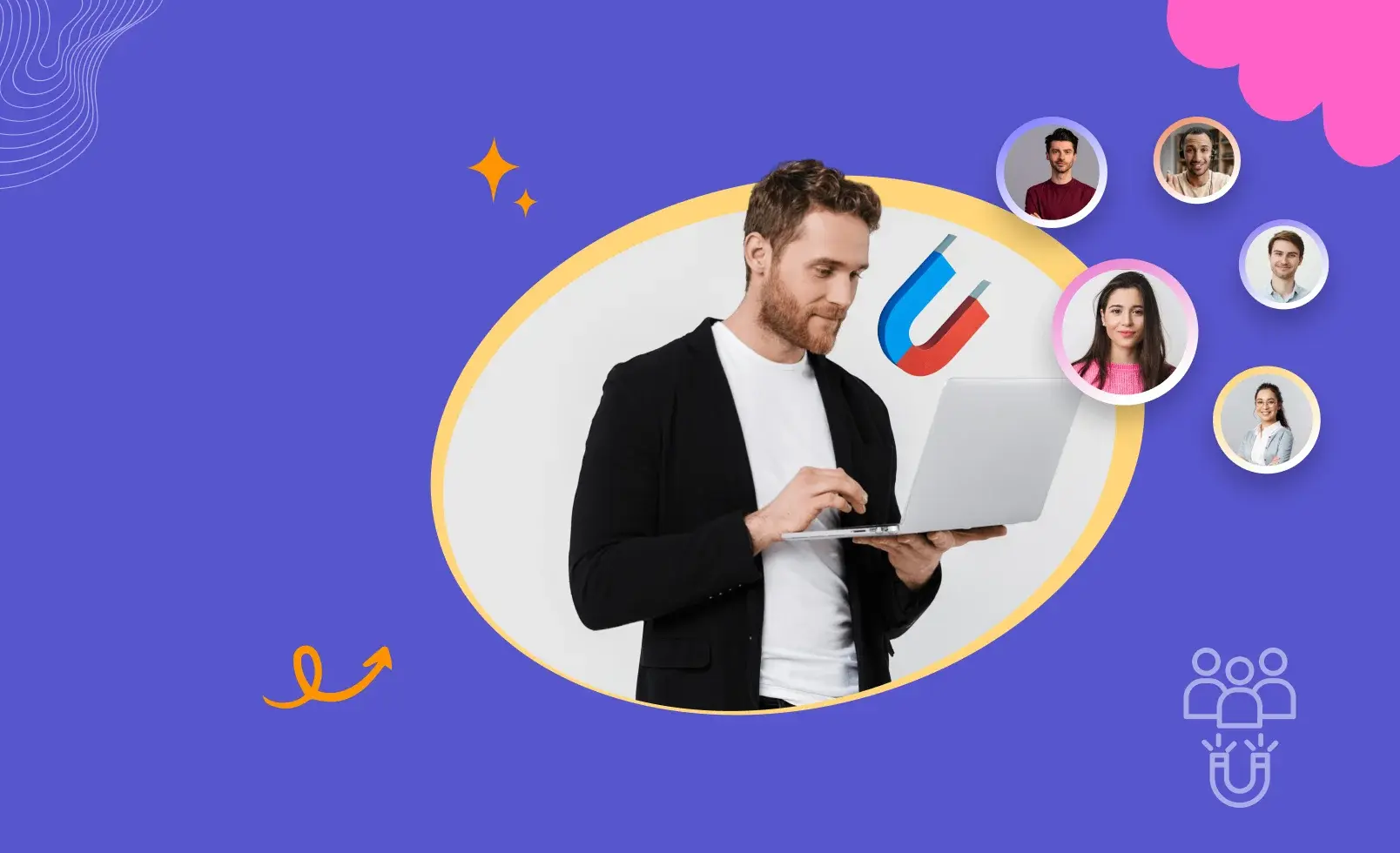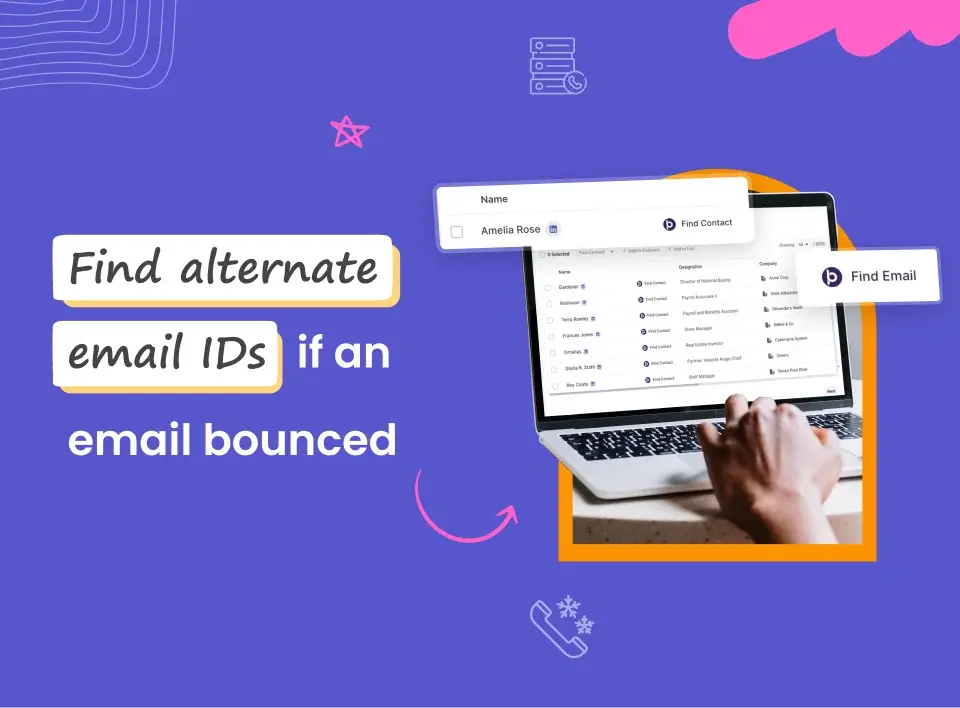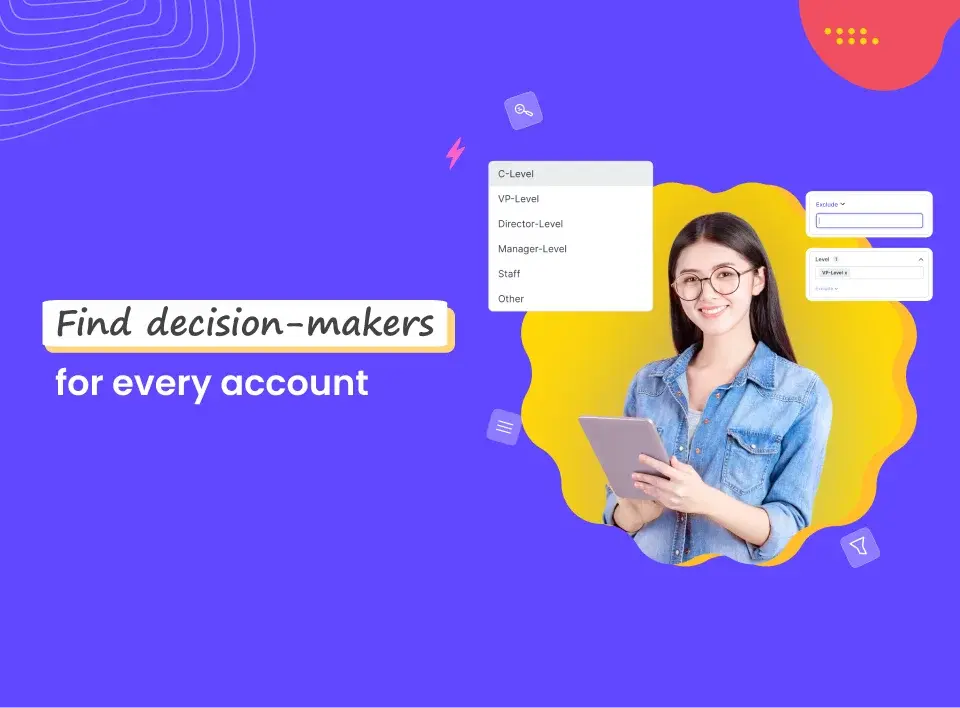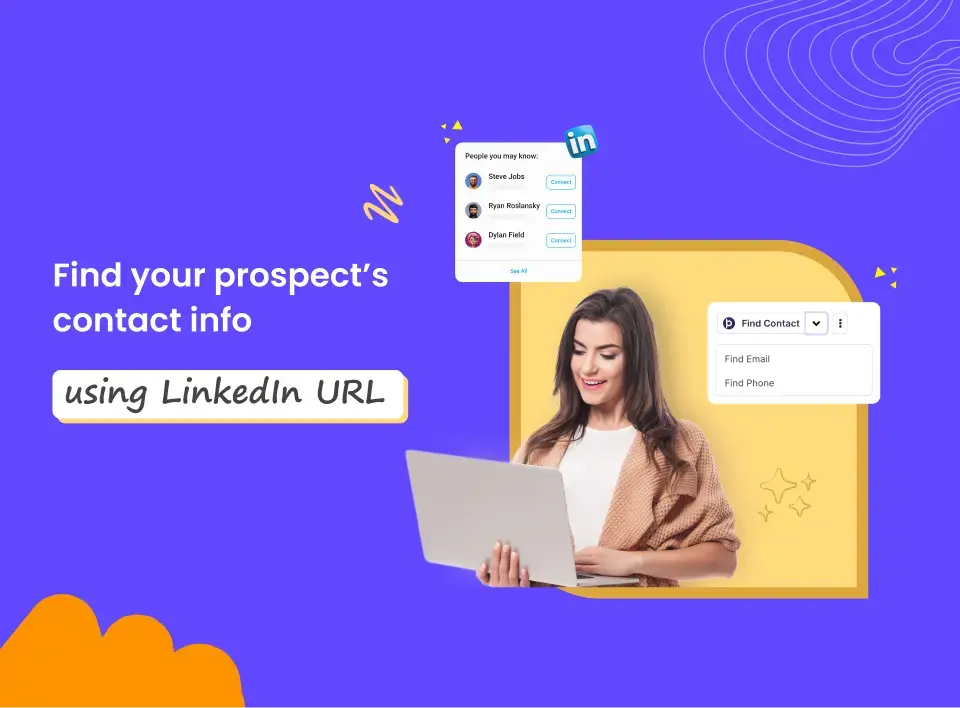Sales is the lifeblood of any business. But what’s the lifeblood of sales?
New leads, of course. So, lead generation is fundamental to business growth—yesterday, today, and forever.
Decades ago, businesses depended on referrals, newspaper advertisements, billboards for generating leads. Thanks to the Internet, salespeople and marketers now have an unlimited number of ways to communicate with their target audience.
But, they still struggle to reach the right audience. After all, if getting leads was easy, every business would be doing it effortlessly. That isn’t the case, obviously.
If companies need to make their lead generation successful, they must approach it like a game of chess. You need to have a strategy for all your pieces, make every move purposeful, and think several moves ahead of your prospects and competitors. Which is what we’re going to tackle here.
In this guide, you’re going to have a sweeping view of B2B lead generation—its importance, types, process, strategies, and tools—to help you predictably generate large volumes of high-quality leads. With a steady stream of leads, you can checkmate your competition and play to win.
Let’s start with the basics first.
What Is a Lead?
A lead is someone who has expressed interest in your company’s offering and potentially be a good fit for your business.
How do they express interest? By typically filling out a form on your website with details like their name, email address, and phone number. “Whether or not they are a high-quality lead isn’t the point—if they’ve registered for something, they are a lead,” explains Aaron Ross and Marylou Tyler in the classic book Predictable Revenue.
Based on where they are in the sales funnel and how they’ve engaged with you, we can classify leads into 3 categories:
- Marketing Qualified Leads (MQLs). A MQL typically expresses interest by engaging with your company’s marketing collateral and following through a specific call to action, like subscribing to your newsletter or downloading content from your website. MQLs are at the very top of the sales funnel as they aren't ready to purchase from you immediately and need some nurturing.
- Sales Qualified Leads (SQLs). These are leads who have engaged directly with your company through the website or another channel to inquire about your offering. SQLs typically request a demo or contact your sales team through phone/email/message indicating their interest in a particular product or service. To improve their chances of connecting, some companies use vanity phone numbers to make their contact information more memorable and enhance brand recognition.
Given their high intent and likelihood of becoming your customer, sales teams should follow up with SQLs as soon as they engage.
- Product Qualified Leads (PQLs). If a lead has used your product before purchasing, like a free trial or free version, and is looking to upgrade to becoming a paying customer, they’re a PQL.
Now that we’re on the same page about what a lead is, let’s see what lead generation means.
What Is Lead Generation?
Lead generation is the collection of all activities executed by sales and marketing teams through which you attract ideal buyers toward your product or service with the goal of converting them into your customers.
B2B companies carry out a mix of marketing and sales activities, like email marketing, content marketing, social media campaigns, and multichannel outreach, to create interest in your offering among buyers, get them to provide their contact information, and finally convert them to customers.
Why Is Lead Generation Important?
Businesses need lead generation the same way a fish needs water—to survive and thrive.
Without a lead generation process in place, you can’t get new customers to keep your business afloat (aka, surviving). And you won’t get new customers in droves to maximize sales and expand your business (aka, thriving).
Feels like an exaggeration? Studies show that companies with mature lead generation processes generate 133% more revenue than average.
Have a look at the various benefits of lead generation for your business:
Generate Revenue Predictably
The logic’s simple here: When you’re able to generate a predictable quantity of leads, you’ll be able to close more deals and drive revenue predictably as well.
Without this predictability in lead generation, sales teams will be forced to hustle at the end of every quarter and year, often unsuccessfully.
Here are some ways in which a predictable lead generation strategy will help you generate predictable revenue:
- Higher return on investment (ROI) as you’ll save resources by only focusing on quality leads that convert.
- Increased customer lifetime value (CLV) as customers are likely to make repeat purchases and refer your business to others.
- Lower customer acquisition cost (CAC) as you optimize your lead generation campaigns to attract high-quality leads.
Have a Healthy Sales Pipeline
Sales expert Brian Tracy puts it best: “Keep your sales pipeline full by prospecting continuously. Always have more people to see than you have time to see them.”
The performance of any sales team can be assessed by the sales pipeline’s health—how consistently reps move leads through the pipeline and how many deals they close.
But the foundation for the above 2 processes is the steady flow of high-quality leads into the pipeline. So, a robust lead generation process will keep your pipeline in the pink of health by having it overflowing with leads at all times.
Focus Efforts on Quality Leads
B2B lead generation empowers organizations to find high-quality leads who have a high likelihood of converting into paying customers. Think of the several hours you can waste trying to convert leads who are a poor fit for your offering. Lead generation helps you eliminate that. You’ll reduce costs and get a higher ROI.
Having generated targeted leads that fit your ideal customer profile (we’ll come to this in a moment), your sales and marketing teams can focus only on personalized messaging to move the leads further down the pipeline.
Improve Brand Visibility
Lead generation helps you leverage multiple channels so that you can reach potential customers wherever they might be in their buying journey, thereby increasing your brand’s visibility. Also, by providing value to leads at all stages of the sales funnel with lead generation activities, you build trust and credibility with your leads, increasing the chances of conversion.
Understand Your Buyer Better
When you run different lead generation campaigns, you’ll end up collecting valuable customer data like contact details and industry information. You can analyze this data to understand your audience better and make data-driven decisions, which will result in effective strategies, improved personalization in your campaigns, and ultimately, delivering a better customer experience.
It’s not for nothing that 67% of B2B marketers rank lead generation as their top concern. Lead generation is a proven strategy to predictably find new customers and drive more revenue.
But how does lead generation work, you ask? That’s where we’re headed next.
What Is the Lead Generation Process?
After all this talk on why lead generation is important, let’s take a look at the steps in a predictable B2B lead generation process, so that you can implement it and start seeing results.
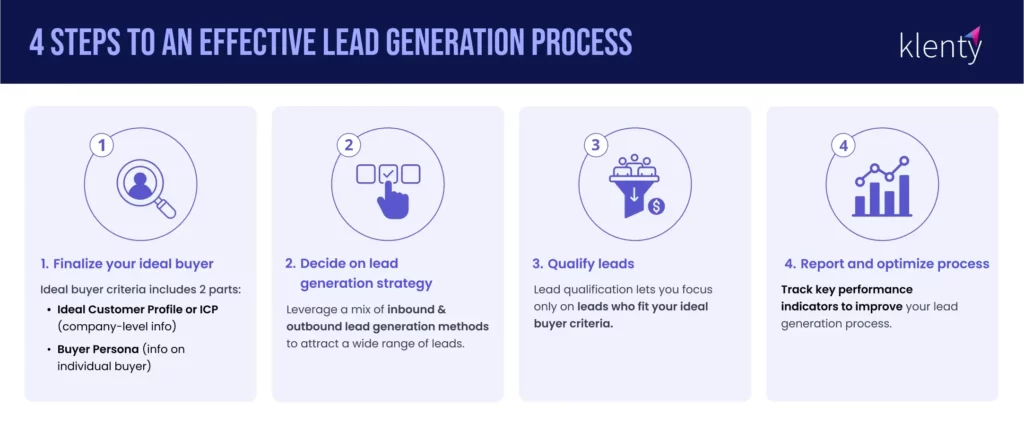
1. Finalize Your Ideal Buyer
Before you even begin your lead generation activities, you need to fix who’s going to be your ideal buyer, and how they’re going to look like. After all, if you try to appeal to everyone, you’ll end up appealing to no one.
There are 2 components of an ideal buyer:
- Ideal Customer Profile (ICP) gives a detailed representation of the perfect company that will benefit the most from your solution. Here, you need to arrive at the following attributes to get the big picture of your ideal purchaser:
- Company size
- Revenue
- Industry
- Budget
- Geography
- Buyer Persona (BP) tells you about the individual buyer you’re targeting. Basically, BP picks up from where ICP left off as it creates a picture of the ideal person you’ll be selling to. This would cover details like:
- Job title
- Decisionmaking capability
- Goals
- Motivators
- Pain points
ICP and BP complement each other. Together, they give you a good idea of how your ideal buyer looks, which helps you to know what a good lead means for your company.
2. Decide on the Lead Generation Strategy
Once you’ve fixed your ideal buyer, it’s time to fix how you’ll find them.
There are several inbound and outbound sales strategies for lead generation like multichannel outreach, content marketing, and paid advertising. (In the next section, we’re going to look at all available strategies in detail.)
Use a mix of inbound and outbound lead generation methods to drive interest for your solution and attract a sizable number of leads.
3. Qualify Leads
Once you implement your lead generation strategy and you start getting leads, you need to start qualifying to identify the ones who are most likely to become your customers.
Lead qualification helps you to identify and focus your efforts only on the best leads and helps you understand the key aspects of a given deal. Both ideal customer profile and buyer persona form the basis for the qualification process, while the qualification methodology involves frameworks like BANT and MEDDPICC.
4. Report and Optimize Process
Having qualified the leads, the sales teams will start prospecting and focusing on closing deals.
But lead generation isn’t a one-time process. To keep fresh leads coming to your business, lead generation has to be a cyclical process with improvements at each iteration.
How do you improve each cycle? You start by first tracking key performance indicators (KPIs) like page views, page visits, conversion rate, cost per lead, customer lifetime value, and attribution channels. Based on your findings, you optimize the lead generation process till these KPIs improve. Rinse and repeat.
For instance, if you find the lead conversion rate to be low, you need to figure out why the leads aren’t converting—whether your lead qualification needs to improve, you’re not engaging leads enough, maybe your content marketing needs some work, whatever.
By figuring out where the problem lies, you’re better positioned to not repeat those mistakes and optimize your lead generation. This way, you’re going to get more and more high-quality leads and customers.
What Are the Types of Lead Generation?
Here’s the final piece of the lead generation puzzle: the different ways by which you can actually generate leads.
Broadly, these ways are classified into 2 types: Inbound and outbound lead generation.
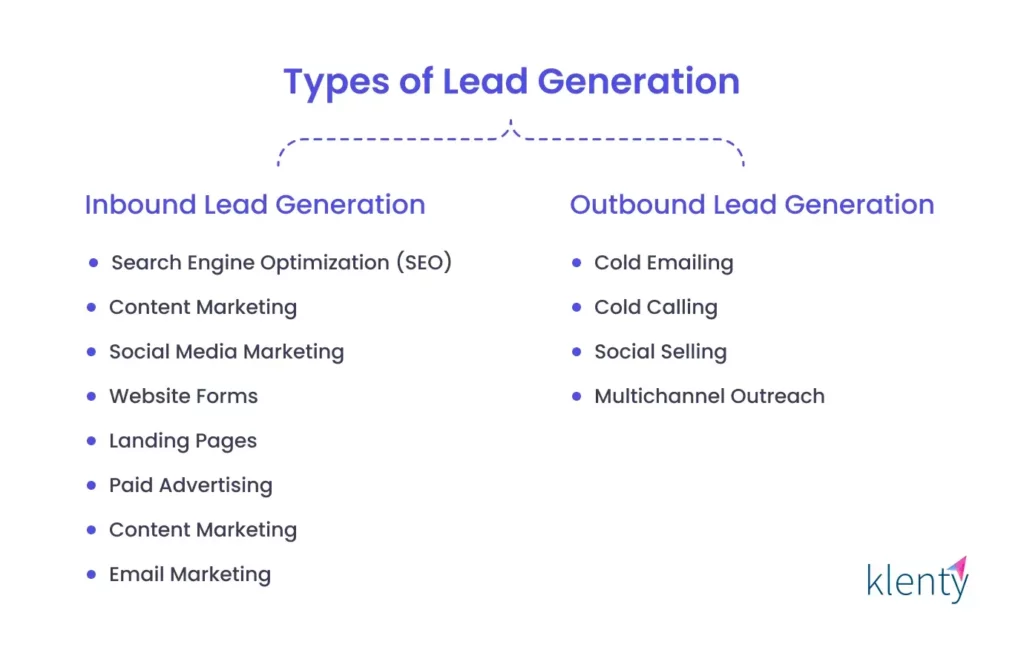
Inbound Lead Generation
As the name suggests, this method aims to generate leads who are inward bound, meaning leads would come to your website on their own.
Inbound lead generation is a collection of methods to attract leads to your website by creating and distributing valuable content tailored to your ideal buyers for different stages of their buying journey.
Inbound means having the right resources that cater to the awareness, consideration, and decision stages of the buyer’s journey. If this is done well, leads will:
- find you when they search online about their challenges or goals,
- evaluate your offering to be a good fit for them, and
- take a desired action (like booking a demo or filling out a form).
Here’s a look at the different ways of inbound lead generation:
- Search engine optimization (SEO). Put simply, SEO is optimizing your content and website to make it easy for search engines to display your content in search results. By this, you increase organic traffic to your website as many potential leads would be able to find your business online.
- Content marketing. Described as the engine that drives inbound lead generation, content marketing involves the creation of different types of valuable content—blogs posts, videos, ebooks, podcasts, webinars, and newsletters—designed to address the goals and challenges of your ideal buyers. For instance, offering a printable poster summarizing key industry trends or best practices can be an effective lead magnet to engage potential customers. By driving organic traffic to your website, content marketing helps you attract qualified leads and build credibility for your business.
- Social media marketing. This strategy involves sharing relevant content tailored to your audience on social media platforms like LinkedIn, X (formerly known as Twitter), and Instagram. Given that nearly 5 billion people use social media, using social media posts can be an effective way to generate quality leads, drive traffic to your website, and build your brand visibility.
- Website forms. Web forms, like contact forms, registration forms, and newsletter signup forms, are used to capture contact information of potential customers. You can collect important lead contact details like email, job title, phone number, region, and address using capture forms to build a contact database.
Experiential and offline capture. Trade shows, in-store events, product demos, and networking meetups are powerful but often underused lead generation opportunities. By equipping reps with tools like scannable posters, mobile lead apps, and Uniqode’s business card with dynamic QR codes, companies can bridge the offline-to-online gap—capturing contact details, tracking interactions, and feeding real-time data into the CRM just like any web-based form.
- Landing pages. A lead generation landing page is a web page that gives a visitor something of value, like a free ebook, a webinar, or a free trial, in exchange for their contact details (email address, name, job title, phone number).
- Paid advertising. Through pay-per-click (PPC) advertisements, you can drive high-quality traffic to your website by running ads on various platforms like search engines (Google and Bing) and social media (LinkedIn and X). It’s called PPC as you only have to only pay when someone clicks one of your ads. These ads usually nudge leads to visit your site, fill out a form, contact you directly, or make a purchase.
- Email marketing. With email marketing, you attract leads by emailing valuable content to those who have already expressed interest in your product or service by providing you with their contact information. Examples include newsletters, content roundups, and discount announcements.
Outbound Lead Generation
This is sort of the opposite of inbound—your efforts have to be outward-bound to find leads wherever they are.
In outbound lead generation, your sales team communicates with potential leads who might not know about your product or your company to generate interest and build a sales pipeline.
The inbound strategy takes a more passive approach to seeking new leads and requires long-term investment. But, outbound lead generation involves the active pursuit of targeted prospects, leading to quicker responses from your customer base and accelerated sales cycles.
Here are some of the common ways to execute outbound lead generation:
- Cold emailing. Cold emailing is about crafting thoughtful, personalized communications to leads with whom you had no prior interactions. Since cold emails are sent to those who haven’t expressed interest in your product or service, it’s not the same as email marketing. A good cold email displays a deep understanding of the recipient's goals and pain points and pitches your product in a way that’s thoughtful and not pushy.
- Cold calling. A sales rep picking up the phone to call a potential lead for the first time and pitching them the solution is cold calling. Successful cold calling techniques include having a strong opener, using personalized cold calling scripts, in-depth product knowledge, and rapport building skills.
- Social selling. Social selling involves leveraging social media platforms like LinkedIn or Twitter to capture quality leads.
- Multichannel outreach. For a winning outbound lead generation, you shouldn’t just stick to one of the above-mentioned channels, but combine all of them to have a multichannel approach. And that’s what customers expect as well: B2B customers can use up to 10 different channels before making a purchase decision, as per McKinsey and Company. For instance, your first point of contact with a potential lead could be a cold email. Then, you send them an InMail message on LinkedIn, and a cold call after that. This way, you’ll reach them in their preferred channels and boost the chances of engagement.
Trade Shows and Conferences
While inbound and outbound are methods for online lead generation, B2B trade shows and conferences are an offline way of generating leads for your business. By setting up a booth representing your company at the event, you’ll get to engage with your target audience in-person by demonstrating your solution’s value. Plus, you’ll also get to build relationships with key decision makers of companies that fit your ICP and boost your overall brand awareness.
Are these trade shows and conferences even worth all the cost and effort? If you’re asking this, here’s an estimate: You can safely generate 20 leads per day at an average trade show.
6 Lead Generation Strategies for Best Results
By now, you should have a full-fledged idea of what lead generation is, its nitty-gritty like the 4-step process and 2 major types, and why it remains essential for businesses.
Sure, lead generation is essential for your sales process. But that doesn’t mean it’s easy.
Look at these 2 data points:
- A Gartner study shows 35% of marketers consider finding new customers as their biggest challenge.
- Another study by Pipedrive shines a light on how 51% of sales professionals are struggling with lead generation.
So, if you want to stand out in your lead generation efforts and beat your competition in this challenging environment, you need a lead generation strategy.
Here, we give you not one but 6 lead generation strategies to help you get high-quality leads always.
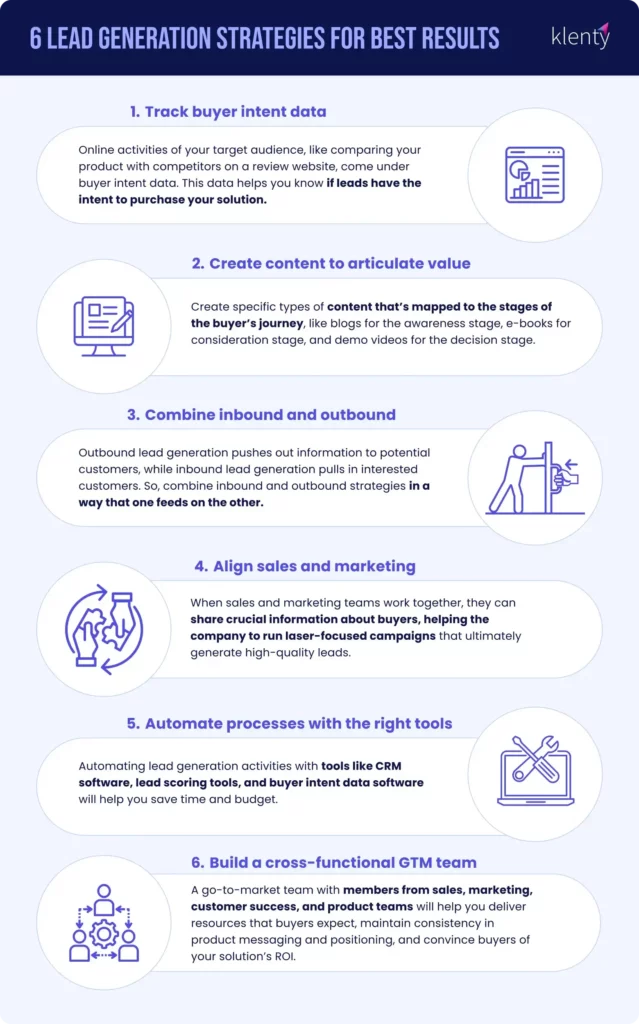
1. Track Buyer Intent Data
To create successful campaigns that speak directly to the needs of your target audience, you need to first understand your buyer’s intent. Buyer intent data is a collection of online activities that your potential buyer does, which indicates their interest in your solution.
Some examples of activities that can be indicative of your lead having purchase intent include:
- Visiting pages in your website that has information on your product’s features, comparisons, reviews, pricing, demo requests, and free trials.
- Comparing other vendors with your product on a third-party review website.
- Downloading your resources such as case studies and e-books.
Incorporating buyer intent data into your lead generation initiatives will help you find more qualified leads, improve the efficiency of your lead generation process, shorten sales cycles, and result in more pipeline.
2. Create Content To Articulate Value
The content strategy you create as part of your lead generation must articulate your solution’s value clearly and not just describe your features or indulge in self-promotion.
To accomplish this, you need to map content to the stages of the buyer’s journey—awareness, consideration, and decision. To do this, create specific types of content for each stage, like:
- Blogs and podcasts for the awareness stage,
- E-books and webinars (gated content) for consideration stage, and
- Product comparison guide and demo videos for the decision stage.
Every piece of content asset should aim to solve the buyer’s specific pain points at these 3 stages to ensure you help potential leads along the entire customer journey and win more deals.
3. Combine Inbound and Outbound
To make your lead generation process foolproof, combine both inbound and outbound strategies. How? By a push-pull approach.
While outbound pushes out information to potential customers, inbound pulls in interested customers. As an example, if you create an outbound campaign where you use a multichannel approach to potential customers about your business, some recipients might either visit your website or look you up online through this. When they do so, they’ll find your inbound-focused content and take the desired action.
4. Align Sales and Marketing
For an outsider, the roles and responsibilities of sales and marketing teams can seem completely different. However, they do share the same long-term goal: Generating more revenue for the company.
This is all the more reason why you should align your sales and marketing teams. By working together, they can share crucial information about buyers, helping the company to run laser-focused campaigns that ultimately generate high-quality leads.
To prevent any conflicts that could hamper the alignment between sales and marketing, you should:
- Fix a specific short-term goal (like generating pipeline worth $X in a month) that’s common to both teams and ensure clear communication on how each team would achieve the goal.
- Define metrics that will be tracked by both sales and marketing, like ICP, buyer persona, customer acquisition cost, opportunities, etc.
- Communicate regularly across teams to ensure everyone is on the same page.
5. Automate Processes With the Right Tools
B2B lead generation process involves crucial tasks like lead qualification, building contact lists, sales outreach, marketing tasks, poring over analytics…the list seems endless.
Doing all these manually will sap your time that you can otherwise spend on revenue-generating activities. So, automating such tasks with the right set of tools will help you save time and budget, as well as make your lead generation more efficient.
Here are examples of software that you should have in your tech stack to automate your lead generation process:
- Customer relationship management (CRM) software to organize and analyze customer data
- Cold email software to manage and automate your email campaigns, track opens and clicks, and personalize your email content for better response rates.
- Lead scoring tools to help teams focus on hot leads that are most likely to convert into sales.
- Buyer intent data software to track the digital activities of leads and gauge their level of interest in your offering.
- SEO and keyword research tools to optimize your website and content for search engines, and find keywords used by your audience.
- Website analytics tools to analyze user activity on your website by tracking their preferences, engagement, and conversion rates.
6. Build a Cross-Functional GTM Team
A go-to-market (GTM) strategy will help your business position your solution for launch, define the ideal buyer, and develop consensus on messaging.
Why is this important? A survey by TrustRadius shows how the B2B buyer looks for self-serve resources to make buying decisions, and is highly risk-averse, who buys only proven solutions that provide ROI quickly.
So, in this selling environment, you must focus on building a cross-functional GTM team comprising key members from the sales, marketing, customer success, and product teams to ensure you:
- Deliver resources that buyers expect from companies, like self-serve product demos, free trials, or hands-on experiences.
- Convince buyers of your offering’s ROI in today’s evolving economy.
- Maintain consistency in product messaging and positioning.
The Best Tool To Find the Right Leads
If you’re a sales rep who focuses on outbound lead generation, there can be several stumbling blocks:
- Wasting hours in manually finding contacts,
- Researching multiple contacts in an account, or
- Calling poor-quality phone numbers.
So, if you’re looking to overcome these and nail your outbound lead gen efforts with accurate phone and email data, look no further than Prospect IQ by Klenty.
With Prospect IQ, sales teams can:
- Filter out prospects based on company name, company size, domain, or specific revenue slabs.
- Create ‘ICP’ and ‘Best Customer Lookalike’ filter views and save time.
- Isolate prospects who belong to specific departments or hierarchy levels and execute high-touch or low-touch strategies accordingly.
- Target prospects with unique needs based on industry, geographic, or technographic data.
That’s not all. The moment you get your contact data, Prospect IQ starts a tailored set of activities for your hot leads and syncs prospect data automatically into your CRM.
Curious to know more about how Prospect IQ can help you achieve your pipeline goals? Book a demo now!
